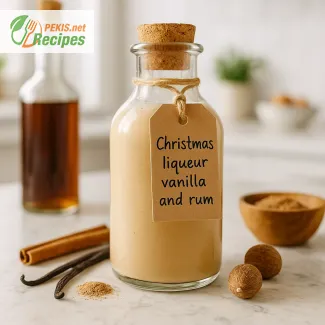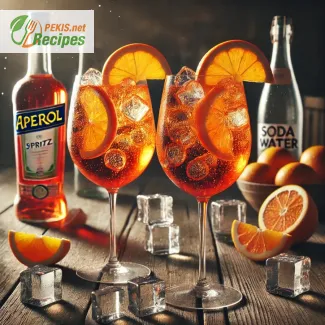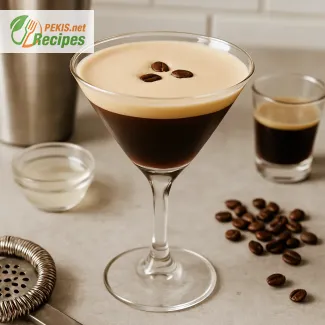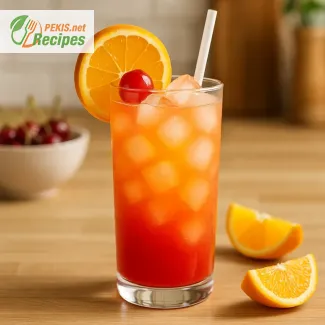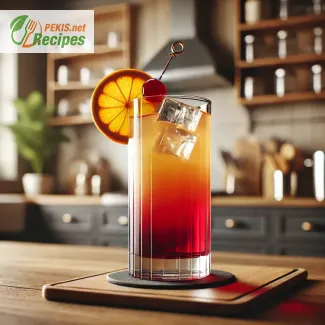Rich, creamy, and perfectly spiced, Christmas liqueur from eggnog transforms classic holiday eggnog into a smooth, aromatic drink that serves 8 portions. Ready in just 30 minutes (20 prep + 10 cook), it blends eggs, cream, vanilla, nutmeg, and rum into a silky liqueur with a festive warmth. Best stored in the fridge for up to 4 weeks, it matures beautifully over time — ideal for gifting or serving chilled over ice with a dusting of nutmeg.
Years of exploring traditional desserts and festive drinks taught me how a simple base like eggnog can evolve into something extraordinary. Balancing spices, cream, and spirits isn’t just about taste — it’s about capturing the feeling of winter warmth in a glass. Every batch of this Christmas liqueur tells its own story, developing depth as it rests and infuses. The key lies in patience, precision, and a genuine love for timeless flavors shared around the table.
PEKIS – professional chef and recipe developer with over 25 years of experience in cooking and baking, specialized in European and international cuisine.

Transform your classic eggnog into a festive Christmas liqueur
A rich, creamy, and aromatic holiday drink that turns tradition into indulgence
When the air fills with the scent of vanilla, nutmeg, and rum, it can only mean one thing — the holidays have arrived. Turning traditional eggnog into a Christmas liqueur is like bottling the warmth of winter evenings and the sparkle of fairy lights. The transformation is simple but magical: a familiar, creamy beverage becomes an elegant, sippable liqueur that carries both nostalgia and sophistication. Each sip offers a smooth balance of sweetness and spice, with undertones of caramel and the delicate heat of alcohol weaving through the velvety texture.
The essence of this homemade Christmas liqueur lies in its harmonious blend of eggs, sugar, milk, cream, and a splash of spirit—usually rum, brandy, or whiskey. These components interact in a way that enhances the lush creaminess of the eggnog, while the alcohol adds a lingering warmth that complements desserts or festive toasts. The final result is a luxurious, golden liqueur that not only looks stunning in a glass bottle but also makes an exceptional homemade gift.
A brief origin story of eggnog and its holiday evolution
The history of eggnog stretches back to medieval England, where “posset,” a warm drink made from milk, eggs, and ale, was a winter favorite among the wealthy. As the recipe traveled across the Atlantic, American colonists began adding local ingredients such as rum and bourbon, creating what we now recognize as the classic eggnog. Over time, the drink became synonymous with Christmas festivities — a symbol of abundance and hospitality. Turning eggnog into a Christmas liqueur is a modern twist on that heritage, blending old-world comfort with contemporary elegance.
Why you’ll love this Christmas eggnog liqueur
- Creamy indulgence – a silky-smooth texture that feels luxurious on the palate.
- Festive aroma – notes of vanilla, nutmeg, cinnamon, and rum evoke cozy winter nights.
- Customizable – you can adjust sweetness, spice, and alcohol level to suit your taste.
- Perfect gift idea – beautiful in glass bottles with a ribbon or label.
- Long shelf life – when stored properly, it stays flavorful for weeks.
How ingredients work together
- Eggs and cream create the rich base, giving body and smoothness.
- Sugar and vanilla bring gentle sweetness that balances the alcohol.
- Nutmeg, cinnamon, or cloves add depth, transforming the drink into a sensory holiday experience.
- Alcohol (rum, brandy, or whiskey) acts as both a flavor enhancer and a natural preservative, ensuring the liqueur matures gracefully.
- A touch of salt can elevate the caramel and vanilla notes, rounding out the flavor.
Each ingredient plays a vital role in balancing texture and aroma. The secret lies in allowing the mixture to rest — a day or two of chilling lets the flavors meld into a unified, mellowed symphony.
Storing and preparing ahead
Homemade Christmas eggnog liqueur keeps beautifully when refrigerated in sterilized glass bottles. Store it tightly sealed for up to three to four weeks, shaking gently before serving. Over time, the flavor deepens, the alcohol softens, and the sweetness integrates more fully. For longer storage, choose a spirit with a higher alcohol content, which naturally extends freshness. It’s ideal to prepare this liqueur a week before Christmas, giving it time to mature just in time for holiday celebrations.
Creative variations and flavor twists
- Chocolate delight – add a spoon of melted dark chocolate or cocoa for a mocha twist.
- Coffee infusion – stir in espresso or coffee liqueur for a rich, aromatic version.
- Caramel dream – incorporate homemade caramel syrup for a buttery sweetness.
- Spiced wonder – enhance with cardamom, star anise, or allspice for an exotic touch.
- Coconut elegance – swap part of the milk for coconut milk for a tropical note.
Serving ideas and pairing inspiration
Serve this liqueur chilled or over ice, topped with whipped cream or a dusting of nutmeg. It complements Christmas desserts like panettone, fruitcake, or ginger cookies, and can also elevate your morning coffee or evening hot chocolate. For a sophisticated twist, drizzle it over vanilla ice cream or mix it into festive cocktails for a creamy, aromatic base.
Sensory and cultural significance
The Christmas eggnog liqueur embodies more than flavor — it’s a reflection of the season’s warmth, generosity, and shared joy. Its velvety mouthfeel, golden hue, and spiced perfume create a multisensory experience that evokes both family gatherings and quiet winter nights. Whether sipped slowly by the fireplace or gifted in a hand-labeled bottle, it transforms a humble tradition into something personal and memorable.
Key entities and semantic richness
This liqueur represents a confluence of holiday traditions, culinary craftsmanship, and seasonal ingredients — from the eggnog base rooted in European heritage to the modern custom of homemade liqueurs. The interplay of spices, dairy, and spirits defines its unique profile, making it one of the most beloved festive drinks across cultures.
Expert tip for perfection
Patience is the secret ingredient. Let the liqueur rest in the refrigerator for at least 48 hours before serving — the alcohol mellows, the spices blend, and the result is smooth, velvety perfection that captures the essence of Christmas in every drop.
- In a large saucepan, pour milk and heavy cream. Warm gently over medium-low heat until just below boiling point (around 80°C / 176°F). Do not let it boil.
- Add sugar, vanilla extract, nutmeg, and cinnamon. Whisk until the sugar dissolves completely, creating a smooth, aromatic base.
- Slowly pour in the eggnog, whisking constantly to prevent curdling. Continue stirring for 2–3 minutes until the mixture becomes creamy and uniform.
- Remove the saucepan from the heat and allow the mixture to cool slightly for 10–15 minutes.
- Once lukewarm, pour in the rum and brandy. Stir thoroughly to combine. Alcohol should never be added to hot liquid, as it may evaporate.
- Add a small pinch of sea salt to enhance sweetness and depth of flavor.
- Using a fine sieve, strain the mixture into sterilized glass bottles or jars to ensure a smooth texture.
- Seal tightly and refrigerate for at least 48 hours before serving to allow the flavors to mature and blend perfectly.
- Serve chilled, optionally topped with whipped cream and a sprinkle of nutmeg (for decoration).
Tips:
- For a lighter texture, replace part of the heavy cream with extra milk.
- For a non-alcoholic version, substitute rum and brandy with rum-flavored extract and extra cream.
- Shake gently before each serving to reincorporate natural separation.
FAQ questionCan I use store-bought eggnog or should I make it from scratch?
Both work. Store-bought eggnog gives consistent thickness and sweetness, letting you fine-tune alcohol and spice. Homemade eggnog offers control over creaminess, sugar, and spice levels, and can be cooked (custard-style) for added stability. Whichever you choose, aim for a pourable, velvety base so the liqueur stays smooth after chilling.
FAQ questionWhich alcohol makes the best flavor balance?
A blend of dark rum and brandy delivers depth and warmth: rum adds molasses-caramel notes, while brandy contributes dried-fruit and vanilla tones. If you prefer a lighter profile, use bourbon for soft oak and vanilla, or spiced rum for bolder aromatics. Keep total ABV moderate so the liqueur tastes rounded, not hot.
FAQ questionHow do I prevent curdling when adding alcohol?
Cool the eggnog base to lukewarm before stirring in spirits. Alcohol + high heat can split dairy; adding it slowly, off heat, while whisking gently, keeps the emulsion intact. If needed, pass the mixture through a fine sieve to guarantee a silky finish.
FAQ questionHow long should it rest before serving, and how long does it keep?
Rest for 48 hours in the fridge to let spices, dairy, and alcohol marry. Properly bottled in sterilized, airtight glass, it keeps up to 4 weeks refrigerated. The flavor mellows and deepens over time; shake gently before pouring to re-combine natural separation.
FAQ questionCan I make a non-alcoholic version that still tastes festive?
Yes. Replace spirits with rum extract or alcohol-free spiced syrup and add a touch more vanilla to boost roundness. For body, maintain the cream-to-milk ratio, and enhance complexity with freshly grated nutmeg and a cinnamon stick infusion. You’ll get a creamy, dessert-like sip that still feels celebratory.
FAQ questionHow can I adjust sweetness and texture without losing balance?
For less sweetness, cut granulated sugar slightly and compensate with vanilla or a pinch of sea salt to highlight flavor. For a lighter texture, increase milk and reduce cream; for richer body, do the opposite. Always make changes incrementally, then chill and taste after resting—flavors soften and integrate in the fridge.
FAQ questionWhat are smart serving and gifting tips?
Serve well-chilled or over ice, with a dusting of fresh nutmeg or a small dollop of lightly sweetened whipped cream. For gifts, use dark glass bottles, label with batch date and resting suggestion, and include a note to shake before serving. Pair with ginger cookies, panettone, or fruitcake to emphasize the liqueur’s creamy spice profile.
The beauty of Christmas liqueur from eggnog lies in its timeless simplicity — a perfect harmony of creaminess, spice, and warmth. Each ingredient contributes to a sensory experience that feels both nostalgic and indulgent. When poured over ice or crowned with a touch of whipped cream, it becomes more than a drink; it becomes a moment of celebration captured in liquid form.
Letting the liqueur rest and mature enhances its depth and smoothness, allowing the flavors of vanilla, nutmeg, and rum to intertwine naturally. Over time, the sweetness mellows, and the texture grows silkier, making every sip richer and more balanced. This slow transformation reflects the essence of the holidays — patience, warmth, and shared joy.
A well-crafted homemade liqueur carries a certain intimacy. It tells a story of careful preparation, family traditions, and culinary creativity. Whether enjoyed at a festive gathering or given as a handcrafted gift, it speaks of thoughtfulness and a deep appreciation for authentic flavors.
Every batch invites a personal touch — maybe a hint of coffee, a swirl of caramel, or an extra dash of spice. That adaptability makes it more than just a recipe; it’s a canvas for taste and tradition, blending comfort with craftsmanship. In every glass of Christmas eggnog liqueur, there’s a little warmth of home, a little sparkle of the season, and a lot of heart.
Allergens present in the recipe:
- Milk – present in eggnog, milk, and cream.
- Eggs – contained in eggnog.
- Alcohol – rum and brandy used for flavor and preservation.
Substitution tips to remove allergens and gluten:
- Replace dairy milk and cream with plant-based alternatives such as almond, oat, or coconut milk.
- Use vegan eggnog made from cashew or soy base to avoid eggs.
- Choose alcohol-free vanilla extract and omit spirits for a family-friendly version.
- Vitamin A – 180 µg – supports healthy vision and skin.
- Calcium – 140 mg – strengthens bones and teeth.
- Vitamin D – 1.2 µg – aids calcium absorption.
- Potassium – 210 mg – helps regulate fluid balance and nerve function.
- Magnesium – 15 mg – supports muscle and energy function.
- Phosphorus – 90 mg – essential for bone structure and energy metabolism.
- Cinnamaldehyde – 2 mg – found in cinnamon, helps reduce inflammation.
- Vanillin – 1 mg – from vanilla extract, promotes relaxation and mood balance.
- Nutmeg phenolics – 0.8 mg – natural compounds supporting digestive health.
- Carotenoids – 0.2 mg – contribute to cellular protection and immune support.
